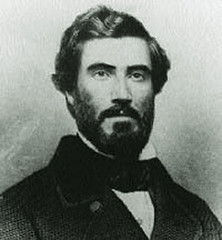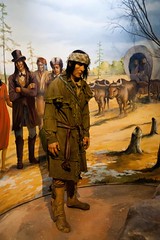Views through Pen and Ink: North Carolina's Antebellum Literature Records an Era
By W. Keats Sparrow
Reprinted with permission from the Tar Heel Junior Historian, Fall 1996.
Tar Heel Junior Historian Association, NC Museum of History
Related Entry: North Carolina Literature Overview
Since the late 1500s, many men and women have written about the area we now call North Carolina—its geography, history, society, and politics. They have written travelogues, diaries, poetry, even propaganda reports for royalty and relatives back in the Old World. In fact, North Carolina easily boasts the longest English-written literary history of any state.
African American Poetry and Frontier Novels
Intriguing literary works began to appear in North Carolina early in the antebellum era. Two of these works were important contributions to literature because they dealt with issues that were debated at that time—issues surrounding slavery and American Indian and European conflict—especially in the eastern United States.
In 1829, just before the era began, a collection of poetry called The Hope of Liberty: Containing a Number of Poetical Pieces was published. George Moses Horton, its author, was an African American slave in Chatham County. He is still referred to as the state's first professional poet, and his contributions are considered among the nation's earliest literary works by an African American. His poetry reveals a hope for liberty felt by an entire culture of oppressed people. Oddly, most blacks could not have read Horton's work (since most were not allowed to learn to read), but white society showed interest and appreciation through purchasing it.
Robert Strange's 1839 epic frontier novel Eoneguski; or, the Cherokee Chief: A Tale of Past Wars provides a look at the hopes and dreams of another culture—American Indian. Strange, a Fayetteville native, used material he gathered as a circuit court judge in western North Carolina to write this novel. Eoneguski is valuable as a record of Cherokee customs and legends, as well as a look at clashes that faced the groups that came together in the early decades of America's settlement.
Novels about Plantation Life and Slavery
Both northerners and southerners were interested in reading about slavery and plantation life in the South.
Gregory Seaworthy's two books Nag's Head; or, Two Months among "The Bankers": A Story of Sea-Shore Life and Manners (1850) and Bertie; or, Life in the Old Field: A Humorous Novel (1851) are considered masterpieces of North Carolina literature from the 1800s. Seaworthy was a pseudonym used by George Higby Throop (pronounced "troop"). Throop was an itinerant schoolmaster from the North who served as a teacher for children on several northeastern North Carolina plantations.
Nag's Head is the story of one of these families that moves to the Outer Banks during a summer  to escape an outbreak of malaria. Throop's accounts of this seaside holiday provide a glimpse into the wealthy planter lifestyle and into the living conditions of this part of the state at the time. Bertie is a superb example of the then-popular plantation novel genre. Its story unfolds through the eyes of a northern visitor who finds romance in the culture, environment, and young people of a plantation in coastal North Carolina in the 1840s. But the visitor finds another side to this life when one of the plantation's young men returns from a northern university with ideas of Yankee abolitionism.
to escape an outbreak of malaria. Throop's accounts of this seaside holiday provide a glimpse into the wealthy planter lifestyle and into the living conditions of this part of the state at the time. Bertie is a superb example of the then-popular plantation novel genre. Its story unfolds through the eyes of a northern visitor who finds romance in the culture, environment, and young people of a plantation in coastal North Carolina in the 1840s. But the visitor finds another side to this life when one of the plantation's young men returns from a northern university with ideas of Yankee abolitionism.
A North Carolina work that focuses on the negative side of the South's slave culture is a work by native son Hinton Rowan Helper. Helper's book, The Impending Crisis of the South, and How to Meet It (1857), attacked slaveholders and warned of an impending slave uprising. Antislavery Republicans from the North printed and circulated one hundred thousand copies of this book during the presidential campaign of 1860 to show that not all southerners supported slavery. Helper was soon run out of the state for promoting his views.
At the time this article was written, W. Keats Sparrow was the dean of the College of Arts and Sciences at East Carolina University in Greenville.
Additional Resources:
ECU, North Carolina Literature Web Sites: http://www.ecu.edu/cs-lib/ncc/NClinks/Webliterature.cfm
The North Carolina Literary and Historical Association. http://litandhist.ncdcr.gov/
DocSouth: Library of Southern Literature Homepage. https://docsouth.unc.edu/southlit/
UNC, North Carolina Literature in the North Carolina Collection. http://www.lib.unc.edu/ncc/literature.html
Image Credit:
Crocket-Miller Slave Quarters. February 24, 2006. James City, North Carolina. Located https://www.flickr.com/photos/zrfraileyphotography/5480099520/. Accessed February 22, 2012.
"Cherokee, North Carolina." October 15, 2011. Located at www.flickr.com/photos/jacqueline_poggi/6730135955/. Accessed February 22, 2012.
Gathman, Allen. "Hinton Rowan Helper." January 25, 2010 Located at https://www.flickr.com/photos/agathman/4980273570/. Accessed February 22, 2012.
1 January 2008 | Sparrow, W. Keats

